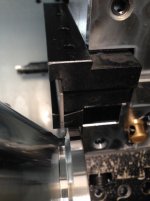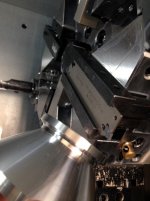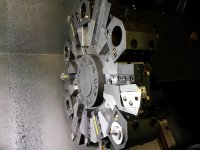I roughed most of the outside with a CCGT insert, and roughed the undercut/finished with my 2.2mm parting tool (Korloy, Sawman, from Exkenna). Turns out if you go slow enough, you can actually do turning with this thing (other than the occasional back chamfer). Of course the finish isn't as nice as if I had used another tool, but it is acceptable until I get something better. The finish was certainly way better than I expected.
I basically held this part from the inside and machined the outside (the part was mounted such that the taper diameter decreases as Z increases). I thought about using a left hand 35 degree holder, which could work, but I would need a really tall set of softjaws to have enough clearance. So I decided to buy an Iscar Cut-Grip holder (ISCAR Cutting Tools - Metal Working Tools - GHDR/L (short pocket) : 2800146 - GHDR 16-3) and related inserts. I need this holder for another set of parts I'm working on as well. Hopefully this is the right tool for the part pictured below.


Cheers,
Matt
I basically held this part from the inside and machined the outside (the part was mounted such that the taper diameter decreases as Z increases). I thought about using a left hand 35 degree holder, which could work, but I would need a really tall set of softjaws to have enough clearance. So I decided to buy an Iscar Cut-Grip holder (ISCAR Cutting Tools - Metal Working Tools - GHDR/L (short pocket) : 2800146 - GHDR 16-3) and related inserts. I need this holder for another set of parts I'm working on as well. Hopefully this is the right tool for the part pictured below.


Cheers,
Matt




